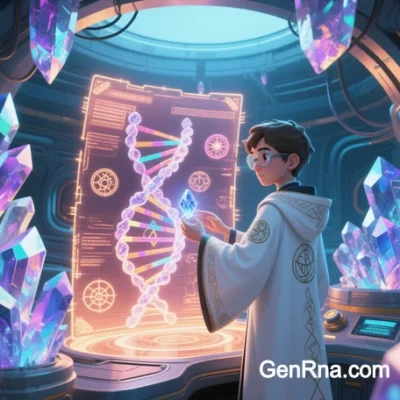 Integrating Nanotechnology, Synthetic Biology, and Computational Innovation
Integrating Nanotechnology, Synthetic Biology, and Computational Innovation
1. Introduction
DNA, the molecular blueprint of life, is poised to transcend its biological role as advances in structural biology, nanotechnology, and computational modeling redefine its potential. The next decade will witness unprecedented exploration of DNA’s conformational plasticity, dynamic assembly, and functional versatility. This article outlines six transformative research directions that will shape the future of DNA structure studies, emphasizing interdisciplinary approaches and real-world applications.
2. Dynamic DNA Architectures: Beyond Static Helices
A. Programmable Nanostructures
DNA’s modularity enables the design of dynamic nanostructures capable of reconfiguration in response to environmental cues (pH, light, or specific biomolecules). Innovations like crisscross polymerization (combining DNA slats with short linkers) allow rapid assembly of micron-scale 3D frameworks, overcoming limitations of traditional DNA origami. Future work will focus on integrating shape-memory polymers to create stimuli-responsive nanorobots for targeted drug delivery.
Suggested Figure: Dynamic DNA nanomachines transitioning between preprogrammed configurations (e.g., closed capsule → open drug-release state).
B. Transient Structures and Kinetic Control
Research will prioritize metastable DNA assemblies that mimic biological processes like chromatin remodeling. For example, ATP-fueled DNA walkers can traverse predefined tracks to deliver payloads, mimicking motor proteins.
3. DNA Polymorphism and Functional Plasticity
A. Non-B DNA Conformations
Alternative structures such as G-quadruplexes (G4), triplex DNA, and Z-DNA are emerging as epigenetic regulators. Advanced tools like nanopore sequencing and cryo-electron tomography (cryo-ET) will map their spatiotemporal distribution in live cells, linking structural transitions to disease states (e.g., G4 accumulation in cancer telomeres).
B. Chiral and Topological Engineering
Synthetic DNA with D-amino acid backbones or left-handed helices could evade nuclease degradation, enhancing therapeutic durability. Hybrid systems combining B-DNA with peptide nucleic acids (PNAs) may enable novel biosensors.
Suggested Figure: Comparative visualization of B-DNA, G4, and Z-DNA conformations using cryo-ET.
4. Convergence with Synthetic Biology
A. Genetically Encoded Nanostructures
Engineered microbes will produce self-replicating DNA frameworks via orthogonal replication systems. E. coli strains expressing T7 RNAP variants could synthesize DNA origami in vivo, bypassing costly in vitro assembly.
B. Hybrid Bio-Inorganic Systems
DNA-templated quantum dots and plasmonic nanoparticles will enable ultra-sensitive diagnostics. Recent breakthroughs in DNA-guided nanowires (e.g., gold-DNA hybrids) show promise for molecular electronics.
Suggested Figure: DNA-origami scaffold organizing quantum dots into a photonic circuit.
5. Computational and AI-Driven Design
A. Predictive Algorithms for Structural Engineering
Machine learning models like DeepG4 and G4Boost will predict DNA folding landscapes, enabling de novo design of functional nanostructures. Generative AI platforms (e.g., AlphaFold-DNA) could simulate multi-state conformational dynamics.
B. Multi-Scale Modeling
Integration of molecular dynamics (MD) simulations with coarse-grained models will elucidate how base-pair fluctuations propagate to chromatin-scale rearrangements. This approach is critical for understanding diseases like progeria, caused by nuclear lamina defects.
Suggested Figure: AI workflow predicting DNA nanostructure stability under varying ionic conditions.
6. Biomedical Translation and Clinical Impact
A. Precision Therapeutics
- DNA Nanocages: pH-responsive containers for CRISPR-Cas9 ribonucleoproteins (RNPs), minimizing off-target effects in gene editing.
- Epigenetic Editors: G4-stabilizing small molecules (e.g., pyridostatin) to silence oncogenes like MYC in lymphoma.
B. Diagnostic Nanodevices
DNAzyme-based sensors will detect cancer biomarkers (e.g., miRNA-21) at attomolar concentrations. Recent advances in nanopore-MSPA (mutational scanning particle analysis) allow single-molecule detection of RNA variants without amplification.
Suggested Figure: DNAzyme sensor releasing fluorescent signal upon target miRNA binding.
7. Ethical and Industrial Challenges
A. Scalable Manufacturing
Reducing costs of phosphoramidite synthesis and optimizing enzymatic DNA production are critical for commercializing DNA-based therapies.
B. Biosecurity and Regulation
Dynamic DNA systems raise concerns about unintended environmental release. Xenobiological containment (e.g., orthogonal ribosomes) will prevent horizontal gene transfer in synthetic organisms.
8. Conclusion
The future of DNA structure research lies at the intersection of nanotechnology, AI, and synthetic biology. By decoding DNA’s structural language and harnessing its programmable logic, scientists will pioneer revolutionary tools for medicine, energy, and computing.
Data Source: Publicly available references.
Contact: chuanchuan810@gmail.com
